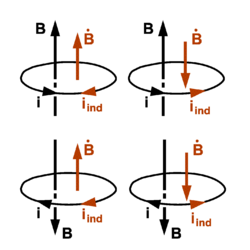Lenz' law: Difference between revisions
imported>Paul Wormer No edit summary |
imported>Paul Wormer No edit summary |
||
| Line 9: | Line 9: | ||
induces a current ''i''<sub>ind</sub> in a conducting loop. The direction of ''i''<sub>ind</sub> is such that the change in field '''B'''(''t'') is opposed. The different cases are illustrated in the figure on the right. Recall here that the direction of current ''i'' and field '''B''' are connected through the right-hand screw rule, that is, a screw is driven in the direction of '''B''' and rotated in the direction of ''i''. | induces a current ''i''<sub>ind</sub> in a conducting loop. The direction of ''i''<sub>ind</sub> is such that the change in field '''B'''(''t'') is opposed. The different cases are illustrated in the figure on the right. Recall here that the direction of current ''i'' and field '''B''' are connected through the right-hand screw rule, that is, a screw is driven in the direction of '''B''' and rotated in the direction of ''i''. | ||
The law is named for the Estonian physicist [[Heinrich Friedrich Emil Lenz]] (1804 – 1865). | The law is named for the Estonian physicist [[Heinrich Friedrich Emil Lenz|Emil Lenz]] (1804 – 1865), who published his law in 1834, shortly after [[Michael Faraday]]'s 1831 discovery of currents induced by moving magnets. Lenz enunciated his law as follows: when a conducting circuit is moved in a magnetic field, the induced current flows in such a direction that the force on it tends to oppose the motion. | ||
Revision as of 08:50, 16 May 2008
In electromagnetism Lenz' law states that a change in magnetic flux Φ (magnetic induction B integrated over a surface S, see this article) gives an induced current that opposes the change in flux.
For the sake of argument we consider the case of a time-dependent magnetic induction B(t) passing through a time-independent surface S. Further we assume that B(t) does not vary over the surface. According to Faraday's law of magnetic induction the time derivative of B(t)
induces a current iind in a conducting loop. The direction of iind is such that the change in field B(t) is opposed. The different cases are illustrated in the figure on the right. Recall here that the direction of current i and field B are connected through the right-hand screw rule, that is, a screw is driven in the direction of B and rotated in the direction of i.
The law is named for the Estonian physicist Emil Lenz (1804 – 1865), who published his law in 1834, shortly after Michael Faraday's 1831 discovery of currents induced by moving magnets. Lenz enunciated his law as follows: when a conducting circuit is moved in a magnetic field, the induced current flows in such a direction that the force on it tends to oppose the motion.


